
The sovereign is a British gold coin with a nominal value of one pound sterling (£1) and contains 0.2354 troy oz of pure gold. Struck since 1817,it was originally a circulating coin that was accepted in Britain and elsewhere in the world;it is now a bullion coin and is sometimes mounted in jewellery. In addition,circulation strikes and proof examples are often collected for their numismatic value. In most recent years,it has borne the design of Saint George and the Dragon on the reverse;the initials of the designer,Benedetto Pistrucci,are visible to the right of the date.

Benedetto Pistrucci was an Italian gem-engraver,medallist and a coin engraver,probably best known for his Saint George and the Dragon design for the British sovereign coin. Pistrucci was commissioned by the British government to create the large Waterloo Medal,a project which took him thirty years to complete.
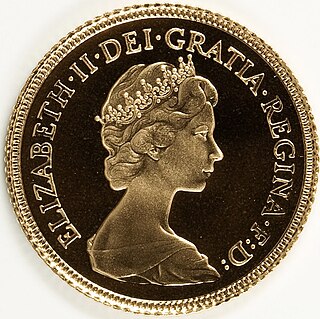
The half sovereign is a British gold coin denominated at one-half of a pound sterling. First issued in its present form in 1817,it has been struck by the Royal Mint in most years since 1980 as a collector's and bullion piece.

The United States Mint is a bureau of the Department of the Treasury responsible for producing coinage for the United States to conduct its trade and commerce,as well as controlling the movement of bullion. The U.S. Mint is one of two U.S. agencies that manufactures physical money. The other is the Bureau of Engraving and Printing,which prints paper currency. The first United States Mint was created in Philadelphia in 1792,and soon joined by other centers,whose coins were identified by their own mint marks. There are currently four active coin-producing mints:Philadelphia,Denver,San Francisco,and West Point.

Christian Gobrecht was the third Chief Engraver of the United States Mint from 1840 until his death in 1844. He was responsible for designing the famous "Seated Liberty" designs,which were in turn the direct inspiration for the design of the Trade Dollar. He designed the Gobrecht Dollar,which was struck in small quantities from 1836 to 1838 and later inspired the Flying Eagle cent. He also designed the obverse sides for the Liberty head Quarter Eagle,Half Eagle,and Eagle gold coins,as well as the "braided hair" type Half cent and Large cent coins.
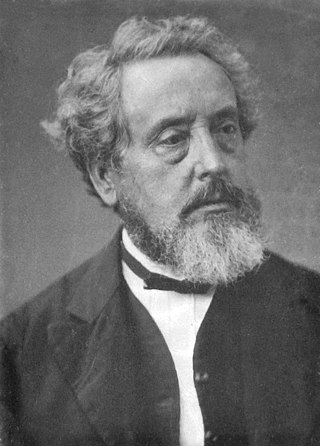
William Barber was Chief Engraver of the United States Mint from 1869 until his death in 1879. He succeeded James B. Longacre in the position.

Charles Edward Barber was an American coin engraver who served as the sixth chief engraver of the United States Mint from 1879 until his death in 1917. He had a long and fruitful career in coinage,designing most of the coins produced at the mint during his time as chief engraver. He did full coin designs,and he designed about 30 medals in his lifetime. The Barber coinage were named after him. In addition,Barber designed a number of commemorative coins,some in partnership with assistant engraver George T. Morgan. For the popular Columbian half dollar,and the Panama-Pacific half dollar and quarter eagle,Barber designed the obverse and Morgan the reverse. Barber also designed the 1883 coins for the Kingdom of Hawaii,and also Cuban coinage of 1915. Barber's design on the Cuba 5 centavo coin remained in use until 1961.
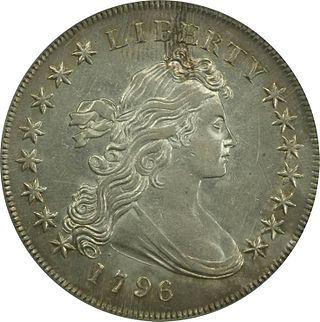
The Draped Bust dollar is a United States dollar coin minted from 1795 to 1803,and was reproduced,dated 1804,into the 1850s. The design succeeded the Flowing Hair dollar,which began mintage in 1794 and was the first silver dollar struck by the United States Mint. The designer is unknown,though the distinction is usually credited to artist Gilbert Stuart. The model is also unknown,though Ann Willing Bingham has been suggested.

The Walking Liberty half dollar is a silver 50-cent piece or half dollar coin that was issued by the United States Mint from 1916 to 1947;it was designed by Adolph A. Weinman,a well-known sculptor and engraver.
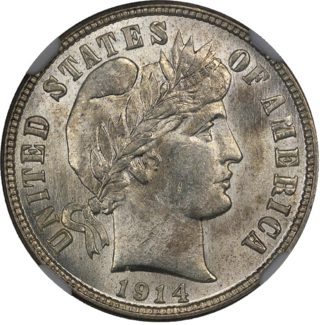
The Barber coinage consists of a dime,quarter,and half dollar designed by United States Bureau of the Mint Chief Engraver Charles E. Barber. They were minted between 1892 and 1916,though no half dollars were struck in the final year of the series.

Montclair Kimberley Academy (MKA) is a co-educational private school for students in pre-kindergarten through twelfth grade located in Montclair in Essex County,in the U.S. state of New Jersey. One of New Jersey's largest independent day schools,Montclair Kimberley Academy celebrated the 125th anniversary of the establishment of its earliest component school in 2012. The current school,established in 1974,is the result of the merger of three separate schools:Montclair Academy,a boys' school founded in 1887;The Kimberley School,a girls' school founded in 1906;and Brookside,a coed school founded in 1925.
Before the introduction of the euro,the current eurozone members issued their own individual national coinage,most of which featured mint marks,privy marks and/or mint master marks. These marks have been continued as a part of the national designs of the euro coins,as well. This article serves to list the information about the various types of identifying marks on euro coins,including engraver and designer initials and the unique edge inscriptions found on the €2 coins.
The Chief Engraver of the United States Mint is the highest staff member at the United States Mint.

James Barton Longacre was an American portraitist and engraver,and the fourth chief engraver of the United States Mint from 1844 until his death. Longacre is best known for designing the Indian Head cent,which entered commerce in 1859,and for the designs of the Shield nickel,Flying Eagle cent and other coins of the mid-19th century.

The Indian Head gold pieces or Pratt-Bigelow gold coins were two separate coin series,identical in design,struck by the United States Mint:a two-and-a-half-dollar piece,or quarter eagle,and a five-dollar coin,or half eagle. The quarter eagle was struck from 1908 to 1915 and from 1925–1929. The half eagle was struck from 1908 to 1916,and in 1929. The pieces remain the only US circulating coins with recessed designs. These coins were the last of their denominations to be struck for circulation,ending series that began in the 1790s.

Renato Signorini was an Italian sculptor,painter and medalist.

The five Panama–Pacific commemorative coins were produced in connection with the 1915 Panama–Pacific International Exposition in San Francisco. Struck at that city's mint,the issue included round and octagonal $50 pieces. Excepting modern bullion coins,these two gold pieces are the highest denomination ever issued and the largest coins ever struck by the United States Mint. The octagonal $50 piece is the only U.S. coin to be issued that is not round.
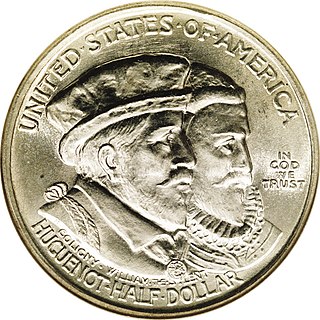
The Huguenot-Walloon half dollar or Huguenot-Walloon Tercentenary half dollar is a commemorative coin issued by the United States Bureau of the Mint in 1924. It marks the 300th anniversary of the voyage of the Nieuw Nederlandt which landed in the New York area in 1624. Many of the passengers were Huguenots from France or Walloons from what is now Belgium;they became early settlers of New York State and the surrounding area.

The Roosevelt dime is the current dime,or ten-cent piece,of the United States. Struck by the United States Mint continuously since 1946,it displays President Franklin D. Roosevelt on the obverse and was authorized soon after his death in 1945.
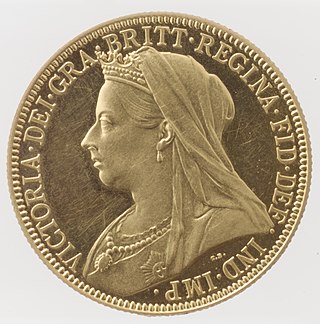
The Old Head coinage or Veiled Head coinage were British coins struck and dated between 1893 and 1901,which featured on the obverse a portrait by Thomas Brock of an aged Queen Victoria wearing a diadem partially hidden by a widow's veil. It replaced the Jubilee coinage,struck since 1887,which had been widely criticised both for the portrait of the Queen,and because the reverses of most of the coins did not state their monetary values. Some denominations continued with their old reverse designs,with Benedetto Pistrucci's design for the sovereign extended to the half sovereign. New designs for some of the silver coinage were inaugurated,created either by Brock or by Edward Poynter,and all denominations less than the crown,or five-shilling piece,stated their values.


















